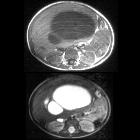chondromesenchymal hamartoma







Chondromesenchymal hamartomas are rare, benign, tumor-like nasal masses in children that have been associated with DICER1 mutations.
Epidemiology
The entity is rare: a systematic review of the literature in 2015 identified fewer than 50 reported cases . The mean age of presentation is 10 years .
Clinical presentation
Patients most commonly present with nasal congestion or mass on examination .
Pathology
Location
The mass is typically centered in the nasal cavity but commonly also involves the paranasal sinuses, orbit, and/or anterior skull base .
Classification
Chondromesenchymal hamartoma was introduced in the World Health Organization classification of head and neck tumors, 4 edition (2016), under the category "Tumors of the nasal cavity, paranasal sinuses, and skull base."
Microscopic appearance
Histology shows nodular hyaline cartilage with a spindle cell stroma .
Genetics
Chondromesenchymal hamartoma is associated with somatic or germline DICER1 mutations . It is therefore part of the phenotypic spectrum of DICER1 tumor predisposition syndrome.
Radiographic features
The imaging appearance is non-specific, consisting of an expansile, circumscribed sinonasal mass .
CT
CT demonstrates polypoid soft tissue in the nasal cavity. There may be osseous erosion, internal calcifications, and cystic components .
MRI
The signal characteristics reflect myxoid stroma with low cellularity and variable vascularity :
- T1: isointense to brain
- T2: heterogeneously hyperintense, with some cystic areas approaching cerebrospinal fluid intensity
- T1 C+: variable enhancement
Differential diagnosis
See the differential for pediatric nasal cavity masses.
Siehe auch:

 Assoziationen und Differentialdiagnosen zu nasales chondromesenchymales Hamartom:
Assoziationen und Differentialdiagnosen zu nasales chondromesenchymales Hamartom:


